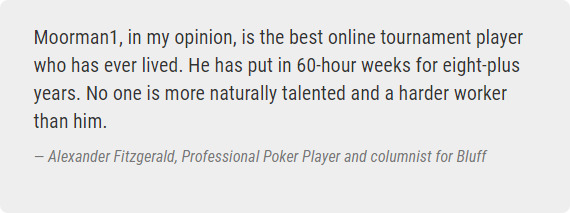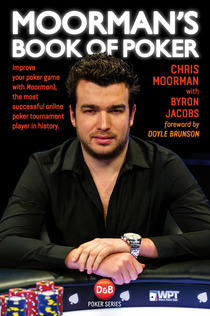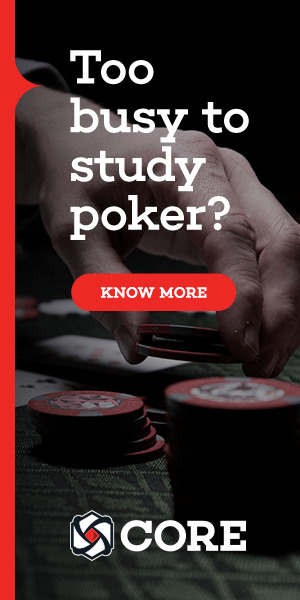20
Mar, 2020
by sixmaxer
|
Mar 20, 2020
|
MTT
turbo
tournaments
strategy
Books
|
0 comments
TL;DR - Moormans book of poker
Reading this amazing book with it's uncensored insight to one of the greatest tournament poker minds will teach you to:
Plan ahead, Use all relevant information at hand, adjust your play based on stack sizes, antes, position, perception of villain etc. and bluff in the right situations.
This must be one of the best poker books for live and/or online tournaments and it is the closest thing you can get to a private poker coaching session with Chris Moorman.
The book comes as paperback, e-book and in a bundle with a video version aswell.
The book comes as paperback, e-book and in a bundle with a video version aswell.
About the Author
At the time the book came out, Chris Moorman had an online cash of more than $11 million. This alone should make anyone interested in whatever he has to say about how to win in poker. There is a lot to learn about how to play poker, to take away from this book - especially for poker tournament players, but anyone interested in learning to see the full picture of a hand from preflop to showdown, can benefit greatly from this book.
If it's good enough for Alex "Assassinato" Fitzgerald...
Clik here to Learn how to win poker tournaments
from a world-class player.
Clik here to Learn how to win poker tournaments
from a world-class player.

Tournament poker strategy
Working your way through the hands in this book, and especially working on implementing Moormans train of thought to your way of seeing the hands, will inevitably be an important step towards learning how to win online poker tournaments. It will not happen overnight, but as with everything else worth fighting for, the slow, steady process will get you there in the end.
80 tournament poker coaching hands
The book is laid out like a poker coaching session, where Moorman coaches the co-author Byron Jacobs. Jacobs is a typical mid-stakes player. There are a total of 80 poker tournament hands, some MTTs, some 6-max turbos, full table turbo as the most common formats. For each of these hands, we first get a sum up, of how the hand played out, preflop, flop, turn and river.
Then we get Jacobs reasoning and thoughts for how he played the hand. Following that, we get Moormans suggestions to how the hand should have been played, and why. Finally, there is a short conclusion from Jacobs about what he learned from the hand or from Moormans input. This layout is practically self paced, live poker training.
If you a not a huge fan of poker math, this book will be a favorite of yours. There is very little math. The book will teach you to assess each situation and take ALL the available info into account - as well as it will teach you to plan ahead before you autopilot and enter the hand preflop, or just fire that flop c-bet without considering if there is a better line. Learning to plan ahead, will give you a huge edge over most of the online player pool.
Then we get Jacobs reasoning and thoughts for how he played the hand. Following that, we get Moormans suggestions to how the hand should have been played, and why. Finally, there is a short conclusion from Jacobs about what he learned from the hand or from Moormans input. This layout is practically self paced, live poker training.
If you a not a huge fan of poker math, this book will be a favorite of yours. There is very little math. The book will teach you to assess each situation and take ALL the available info into account - as well as it will teach you to plan ahead before you autopilot and enter the hand preflop, or just fire that flop c-bet without considering if there is a better line. Learning to plan ahead, will give you a huge edge over most of the online player pool.
Sick and tired of losing online poker?
Try the hypnotic sensation,
when you exploit and own your opponents
Try the hypnotic sensation,
when you exploit and own your opponents

The courage of Byron Jacobs
Reading the book, it is hard not to admire the courage that Jacobs shows, by participating. It must take quite some guts to publicly show all your weaknesses and mistakes, and on top of that knowing, that even when you put in your best effort, your train of thought is very likely to be pulled to pieces by a real pro.
The thing that really convinced me, that there was some powerful material to learn from in this book, was that whenever I read Jacobs reasoning, it all made sense to me, and I was most often thinking, I agree, I'd play this hand the same way. Then Moorman enters the scene, and lays out the law., and you feel ashamed about all the information you missed taking into consideration about finding the best line for this particular hand.
The thing that really convinced me, that there was some powerful material to learn from in this book, was that whenever I read Jacobs reasoning, it all made sense to me, and I was most often thinking, I agree, I'd play this hand the same way. Then Moorman enters the scene, and lays out the law., and you feel ashamed about all the information you missed taking into consideration about finding the best line for this particular hand.
The amateur and the poker pro
While working your way through the book, one thing in particular, becomes obvious to distinguish the difference between the amateur and the pro. Jacobs, who would probably do very well against most of us primarily focuses on the current street - should I call, raise or fold. In contradiction to this, Moorman outweighs the potential and possibilities all the way to the river, before he decides whether to enter the hand or not.
Similarly, Moorman often (before c-betting the flop), often explains a situation in this way if we c-bet, and this player calls, we could barrel on these cards on the turn, and then continue if these cards come on the river. Much like a chess player who thinks several moves ahead. This example is actually from Chris' own introduction to the book, and he definitely lives up to it, throughout the book.
Similarly, Moorman often (before c-betting the flop), often explains a situation in this way if we c-bet, and this player calls, we could barrel on these cards on the turn, and then continue if these cards come on the river. Much like a chess player who thinks several moves ahead. This example is actually from Chris' own introduction to the book, and he definitely lives up to it, throughout the book.
Learn tournament poker from the very best.
Click here to see the authentic reviews on the publishers site.
Click here to see the authentic reviews on the publishers site.

Adjusting to players
Another very interesting take away from the book, is Moormans reasoning for adjusting your play depending on stack sizes, antes, how the table is playing, position, players yet to act, perception of villain and numerous other things. It is not uncommon for the hands, that Moormans suggested choice of action is something, that had not even crossed Jacobs mind, when playing the hand - nor mine, when trying to be Moorman on Jacobs, before reading the 'truth'.
Learn when to bluff
We all know that bluffing is part of the game. Most of us however fail to recognize the correct spots to pull a bluff. There are several jaw-dropping hands presented, where I would normally just have just folded and thought nothing more of it, so learning to recognize these spots, will skyrocket your chances of cashing out more.

